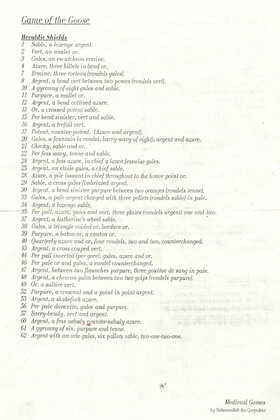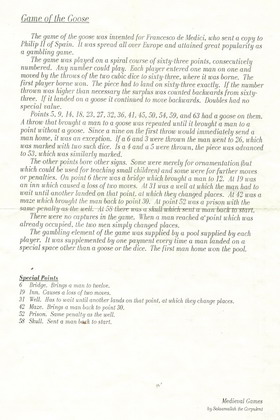Giochi dell'Oca e di percorso
(by Luigi Ciompi & Adrian Seville)
(by Luigi Ciompi & Adrian Seville)

|
Giochi dell'Oca e di percorso
(by Luigi Ciompi & Adrian Seville) |

|
 |

Torna alla ricerca giochi (back to game search) |
 |
| Game of the Goose, a Medieval Board Game | ||
 |
Versione stampabile
 |
Invia una segnalazione

|
  |
primo autore: | Non indicato |
| secondo autore: | Salaamallah the Corpulent | |
| anno: | 19-- | |
| luogo: |
USA-New York |
|
| periodo: | XX secolo (? /4) | |
| percorso: | Percorso di 63 caselle numerate | |
| materiale: | stoffa | |
| dimensioni: | 445X435 | |
| stampa: | Stampa su stoffa | |
| luogo acquisto: | USA-New York | |
| data acquisto: | 20-08-2001 | |
| dimensioni confezione: | ||
| numero caselle: | 63 | |
| categoria: | Araldica | |
| tipo di gioco: | Gioco oca variante | |
| editore: | by Salaamallah the Corpulent | |
| stampatore: | by Salaamallah the Corpulent | |
| proprietario: | Collezione L. Ciompi | |
| autore delle foto: | L. Ciompi | |
| numero di catalogo: | 781 | |
| descrizione: |
Gioco di 63 caselle numerate, spirale (quadrato), antiorario, centripeto, stampato su stoffa. Nelle caselle degli scudi colorati in maniera differente e le caselle classiche del gioco dell'oca. REGOLE: allegate al gioco. Game of the Goose The game of the goose was invented for Francesco de Medici, who sent a copy to Philip II of Spain. It was spread all over Europe and attained great popularity as a gambling game. The game was played on a spiral course of sixty-three points, consecutively numbered. Any number could play. Each player entered one man on one and moved by the throws of the two cubic dice to sixty-three, where it was borne. The first player borne won. The piece had to land on sixty-three exactly. If the number yhrown was higher than necessary the surplus was counted backwards from sixty-tlhree. If it landed on a goose it continued to move backwards. Doubles had no special value. Points 5, 9, 14,18, 23, 27, 32, 36, 41, 45, 50, 54, 59, and 63 had a goose on them. A throw that brought a man to a goose was repeated until it brought a man to a point without a goose. Since a nine on the first throw would immediately send a man home, it was an exception. If a 6 and 3 were thrown the man went to 26, which was marked with two such dice. Is a 4 and a 5 were thrown, the piece was advanced to 53, which was similarly marked. The other points bore other signs. Some were merely for ornamentation (but which could be used far teaching small children) and some were for further moves or penalties. On point 6 there was a bridge which brought a man to 12. Al 19 was an inn which caused a loss of two moves. At 31 was a well at which the man had to wait until another landed on that point, at which they changed places. At 42 was a maze which brought the man back to point 30. At point 52 was a prison with the same penalty as the well. At 58 there was a skull wich sent a man back to start. There were no captures in the game. When a man reached a point which was already occupied, the two men simply changed places. The gambling element of the game was supplied by a pool supplied by each player. It was supplemented by one payment every time a man landed on a special space other than a goose or the dice. The first man home won the pool. Special Points 6 Bridge. Brings a man to twelve. 19 Inn. Causes a loss or two moves. 31 Well. Has to wait until another lands on that point, at which they change places. 42 Maze. Brings a man back to point 30. 52 Prison. Same penalty as the well. 58 Skull. Sent a man back to start. Game of the Goose, Heraldic Shields 1.Sable, a lozenge argent. 2.Vert, an anulet or. 3.Gules, an escutcheon ermine. 4.Azure, three billets in bend or. 7.Ermine, three torteau (rondels gules), 8.Argent, a bend vert between two pomes (rondels vert), 10.A gyronny of eight gules and sable, 11.Purpure, a mullet or. 12.Argent, a bend cottised azure. 13.Or, a crossed potent sable. 15.Per bend sinister, vert and sable, 16.Argent, a trefoil vert. 17.Potent, counter-potent. (Azure and argent). 20.Gules, a fountain (a rondel, barry-wavy of eight), argent and azure. 21.Chechy, sable and or. 22.Per fess wavy, tenne and sable. 24.Argent, a fess azure, in chief a lance fesswise gules. 25.Argent, an etoile gules, a chief sable. 28.Azure, a pile issuant in chief throughout to the honor point or. 29.Sable, a cross gules fimbriated argent. 30.Argent, a bend sinister purpure between two oranges (rondels tenne). 33.Gules, a pale argent charged with three pellets (rondels sable) in pale. 34.Argent, a lozenge sable. 35.Per pall, azure, gules and vert, three plates (rndels argent) one and two, 37.Argent, a Katherine's wheel sable. 38.Gules, a triangle voided or, bordure or. 39.Purpure, a baton or, a canton or. 40.Quarterly azure and or, four rondels, two and two, counterchanged. 43.Argent, a cross couped vert, 44.Per pall inverted (per gore), gules, azure and or. 46.Per pale or and gules, a rondel counterchanged. 47.Argent, between two flaunches purpure, thre gouttae de sang in pale. 48.Argent, a chevron gules between two two golps (rondels purpure), 49.Or, a saltire vert. 52.Purpure, a crescent and a point in point argent. 55.Argent, a shakefork azure. 56.Per pale dancette, gules and purpure, 57.Barry-bendy, vert and argent. 60.Argent, a fess nebuly counter-nebuly azure, 61.A gyronny of six, purpure and tenne. 62.Argent with an orle gules, six pallets sable, two-one-two-one. Medieval Games by Salaamallah the Corpulent |
|
| bibliografia: | ||
Vai alla ricerca giochi Vai all'elenco autori